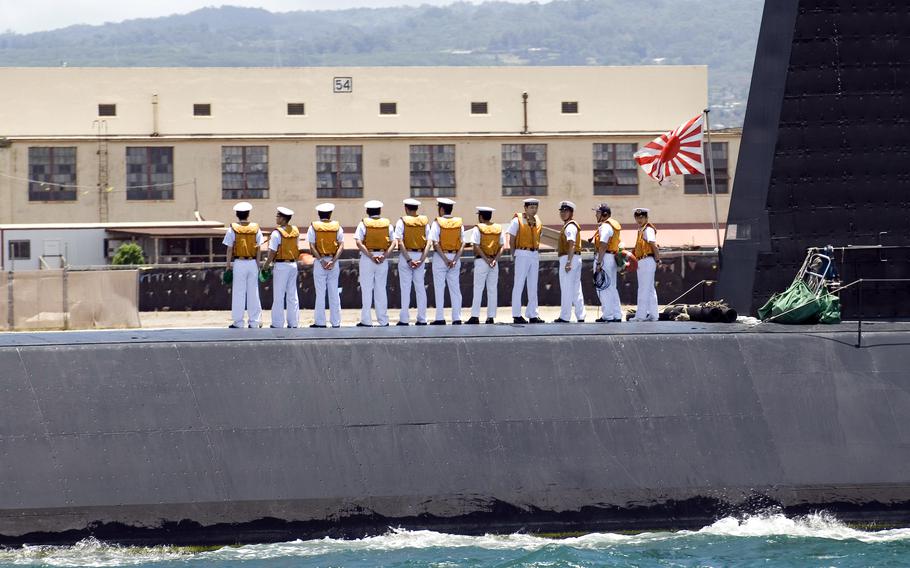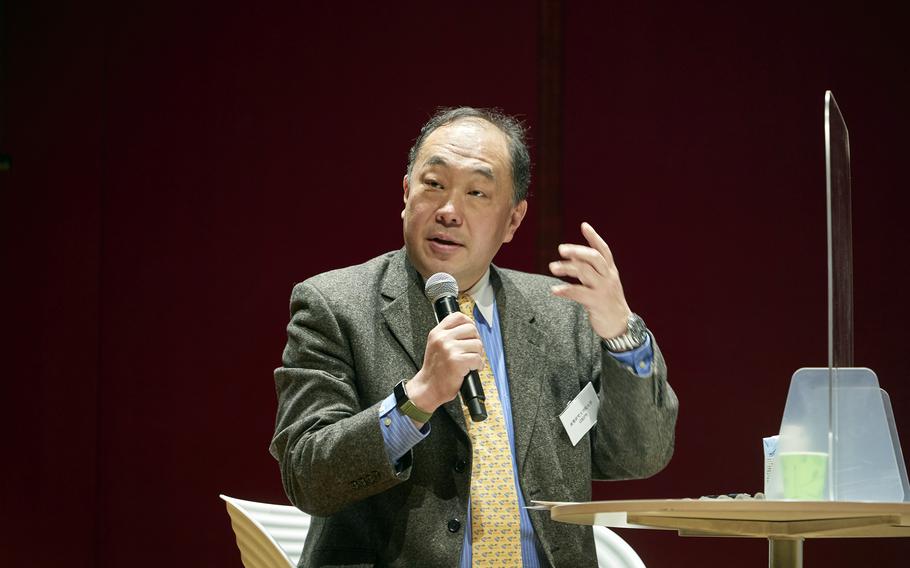
The JS Narushio, a Japan Maritime Self Defense Force submarine, arrives in Pearl Harbor, Hawaii, for Rim of the Pacific drills in 2008. (Paul Honnick/U.S. Navy)
TOKYO — Japan’s Maritime Self-Defense Force wants to be part of a nuclear submarine program announced this week by the United States, United Kingdom and Australia, according to an academic who spoke at a recent Indo-Pacific defense forum in Tokyo.
The leaders of the AUKUS allies — President Joe Biden, Australian Prime Minister Anthony Albanese and U.K. Prime Minister Rishi Sunak — unveiled the submarine deal Monday, part of an effort to counter Chinese expansionism in the Indo-Pacific.
Under the deal, Australia aims to launch its own nuclear-powered subs in the 2030s. A rotational force of U.S. and British subs will operate from Western Australia starting in 2027.
“Japan’s navy would like to be part of these relationships and access this technology,” Tosh Minohara, a professor of U.S.-Japan relations and diplomatic history at Kobe University, said during Building a Free and Open Indo-Pacific: A Debate before the G-7 Summit in Hiroshima.
The forum, held March 10 at the National Graduate Institute for Policy Studies in Tokyo, included diplomats, military officers and journalists.
“Nuclear subs can travel long and fast,” he said. “It will be interesting to see if AUKUS eventually expands to include Japan.”

Tosh Minohara, a professor of U.S.-Japan relations and diplomatic history at Kobe University, speaks at the National Graduate Institute for Policy Studies in Tokyo on March 10, 2023. (National Graduate Institute for Policy Studies)
The U.S. Navy’s Submarine Group 7 is headquartered at Yokosuka Naval Base, Japan, although its submarines are homeported on Guam.
Japan has wanted to be part of AUKUS since the pact was established in September 2021, according to Brad Glosserman, deputy director and visiting professor at the Center for Rule-Making Strategies at Tama University in Tokyo.
Japan recently lifted a self-imposed ban on overseas military sales after it lost to France on a deal to build conventional submarines for Australia. Australia canceled the French deal in favor of nuclear-powered boats built by AUKUS powers.
Including Japan in AUKUS makes sense, Glosserman wrote in an email Thursday.
“Think of it as a tech agreement, not just subs, and the pieces fit together,” he said, noting that Japan is already developing new fighter jets with the United Kingdom and Italy.
Japan’s membership in AUKUS would change the defense pact’s Anglosphere image, Glosserman added.
“However, and as always, the sticking point is information security in Japan,” he said.
The AUKUS powers already have their hands full with the goal of providing nuclear-powered subs to Australia, said James Brown, an international affairs expert at Temple University’s Japan campus.
“I don't think there is the capacity to make further commitments,” he wrote in an email Thursday.
Australia, the UK and the U.S., along with Canada and New Zealand, are partners in the Five Eyes intelligence alliance and have a high level of trust that does not extend to Japan, Brown said.
“To take just one example, the AUKUS three have well-established systems of security clearance, while Japan has work to do in this area,” he said.